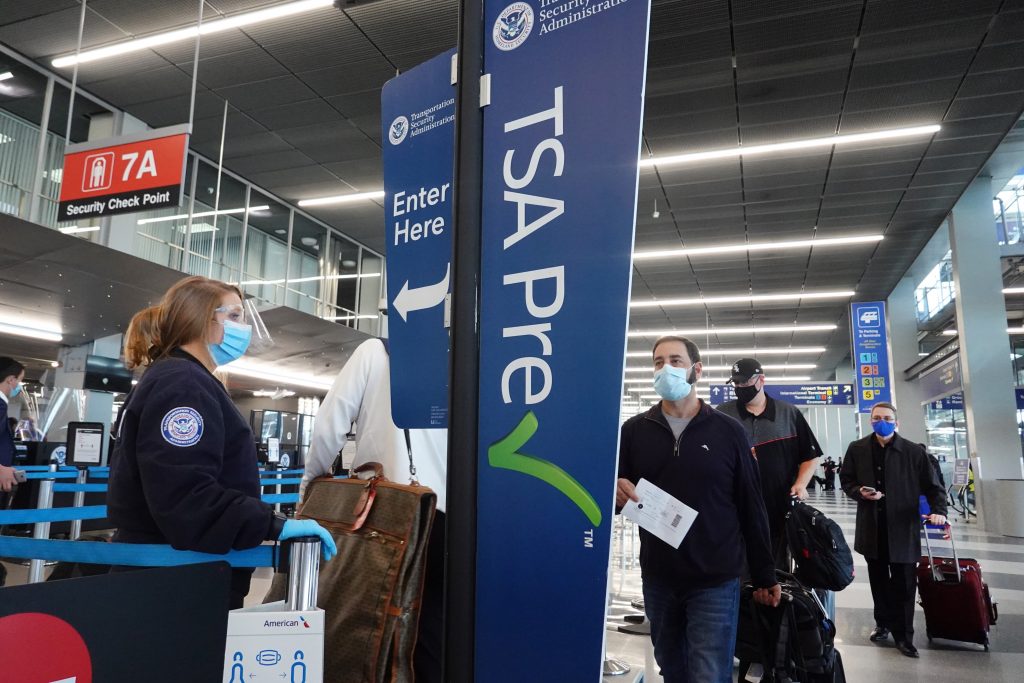Here’s how you can get through TSA faster
Signing up for credit cards through partner links earns us a commission. Terms apply to the offers listed on this page. Here’s our full advertising policy: How we make money.
Update: One or more card offers in this post are no longer available. Check our Hot Deals for the latest offers.
As more vaccinations are rolled out and the world continues to reopen, people are thinking about travel again more than ever. For those who have been staying home since the start of the COVID-19 pandemic over a year ago, there’s finally something to look forward to — the chance to make up for lost trips, take previously canceled family vacations, or have long-awaited reunions with loved ones.
This also means you won’t be the only one at the airport.
Before the vacation fun begins, travelers will still have to get through airport security, an undeniably tedious experience that can be especially strenuous for someone flying for the first time in ages, those with medical conditions, larger groups, and families traveling with children or pets.
Luckily, with a little practice and by following a few of our tips to help you ace your next TSA screening, this part of your trip can be easier for everyone, whether you’re traveling solo or bringing along the whole family along for the ride.
Here’s a quick refresher on everything you need to know to successfully get through a TSA airport security checkpoint quickly and efficiently so you can get started on that much-needed vacation.

COVID-19’s impact on the TSA
Due to COVID-19, several air travel security procedures have changed.

Travelers must stay socially distanced and wear face masks, though you’ll need to adjust your mask to verify your identity or if an alarm goes off, while security officers must wear masks and gloves at all times.
To limit physical contact, you’re allowed to keep phones, belts, wallets, and keys in your carry-on instead of placing them into bins — food must still be screened via bin — and you must scan your boarding pass and show it to the TSA officer rather than handing it over.
Frequently touched surfaces are being sanitized, and for now, you can carry on one large container of hand sanitizer up to 12 ounces. Note that security staff presence has decreased due to fluctuating passenger numbers, so allow extra time for delays.
For a better chance at breezing through airport security, consider signing up for a Trusted Traveler Program like TSA PreCheck or Global Entry (which includes TSA PreCheck).
Due to the pandemic, several U.S. Customs and Border Protection procedures were adjusted to help protect passengers and staff. For instance, mask-wearing and social distancing are mandatory at enrollment center interviews, which must be booked in advance, while conditionally-approved Global Entry applicants can opt for Enrollment on Arrival.
Note that other Trusted Traveler Programs like NEXUS and SENTRI, which are geared toward border crossings with Canada and Mexico, have been put on hold until further notice.
Want to get through TSA faster? Enroll in a Trusted Traveler Program
While Trusted Traveler Programs allow for expedited security sessions, each has its own perks. For $85, TSA PreCheck is better suited for domestic travel, allowing you to keep your shoes, belts, and light jackets on and any 3-1-1 liquids and laptops in your carry-on at over 200 U.S. airports for five years. Note that children under the age of 12 may accompany parents with TSA PreCheck, while those over age 13 must apply separately.
Global Entry, on the other hand, costs $100 for five years of access to shorter lines at self-service kiosks and E-Gates whenever you fly back into the U.S. from an international destination. Best of all, Global Entry includes TSA PreCheck membership, saving you time whether you’re flying domestically or internationally.
Both Global Entry and TSA PreCheck renewal can be completed online up to six months ahead of expiration, though more interviews or fingerprints may be required in person.
Don’t want to pay extra for Global Entry or TSA PreCheck? Consider signing up for a travel credit card that offers credits to reimburse you for application fees every four to five years, depending on the card.
Cards like The Platinum Card® from American Express, Chase Sapphire Reserve®, Capital One Venture Rewards Credit Card and United℠ Explorer Card all offer this special perk, giving you complimentary access to a faster airport security experience.
Tips for getting through TSA
Pack appropriately
Officially, TSA has no rules regarding the size of carry-on bags — those are left up to the airlines — but in general, as long as your bag measures 22 inches (56 cm) in length by 14 inches (36 cm) in width by 9 inches (23 cm) in height, or is small enough to fit into an overhead bin, you’re golden. You’ll face extra fees if your intended carry-on is too big, so double-check with your airline before you get to the airport.
As far as toiletries, each traveler is allowed to bring travel-sized liquids, gels, or aerosols under 3.4-ounces (100 ml), including shampoo, conditioner, toothpaste, lotions, mouthwash, and makeup, into one one-quart resealable clear bag. All passengers must follow the 3-1-1 liquids rule.
If you’re traveling without TSA PreCheck, keep that clear bag near the top of your carry-on bag for easy access at security — you’ll need to put it into a bin, while those with TSA PreCheck can save time by keeping it in their carry-on.
Any containers larger than 3.4 ounces must be checked. Note that it’s okay to pack solid foods, but anything with a creamy, liquid or gel-like consistency counts as a 3-1-1 liquid and belongs in your clear bag. Cold packs and frozen foods can also be carried on, but only if frozen solid.
There are a few exceptions: medications (and the necessary ice packs needed to keep them cool), as well as breast milk, formula, baby food and juice for young children. Due to TSA’s new COVID-19 protocols, you’re also allowed to carry on one large container of hand sanitizer measuring up to 12 ounces.
As you can imagine, firearms, razor blades, large sharp objects, and flammable materials aren’t allowed in your carry-on. Beauty items like tweezers, disposable razors, and nail clippers are acceptable, as are medical devices like insulin pumps, wheelchairs, walkers, and canes.
You can carry on disposable lighters, toy light sabers, crochet hooks, sewing needles, cigar cutters, safety pins, rounded or plastic butter knive, golf tees, fishing rods, boxing gloves, and other sports equipment, but not large items like baseball bats, golf clubs lacross sticks, or other blunt objects that could be utilized as a weapon.
While laptops and other electronics must be taken out of your bag and put into the security bins for an X-ray — those with TSA PreCheck can just leave them in their carry-ons — the TSA website recommends keeping undeveloped film in your bag or handing it over for a closer look at the security checkpoint. Remember that Samsung Galaxy Note 7 phones must never be brought onto the plane, as there have been significant issues with their batteries.
Be sure to pack any important medications or medical devices like IV bags, pumps, syringes, and freezer packs in your carry-on in case your checked bag gets lost or delayed. The TSA website states that medically necessary liquids, gels, and aerosols in “reasonable quantities” are allowed as long as you declare them, so keep these labeled and separate from your other belongings at the checkpoint. Note that additional screening may be necessary to test your medications and devices for explosives or other hidden items. Please check the TSA website for further details, which are listed for a number of medical conditions.
Weigh your bags before you arrive
Nothing puts a damper on a vacation like being told your luggage weighs too much and you’ll need to pay extra fees or ditch some of your items.
While it’s usually more of an issue with international airlines than domestic carriers, it’s still a good idea to make sure your checked and carry-on bags are below the airline’s weight limits ahead of time, either by purchasing a travel scale or using the scales by the check-in desk to double-check baggage weights before you head to airport security.
Dress accordingly
Make things easier by wearing shoes that are easy to slip on and off — if you have TSA PreCheck, you’ll get to keep them on — or by traveling without a belt, jacket, or lots of jewelry, though you’re currently allowed to forgo the bins and keep them in your carry-on thanks to TSA’s COVID-19 protocols.
In general, limit the amount of metal in your clothing, jewelry, and shoes to avoid setting off alarms. Those traveling with head coverings or other religious garments may be subject to additional screening such as a pat-down or may need to remove them in a private screening room for further inspection, though they can be worn. Note that children under 12 and those over 75 can keep their shoes and light jackets on.
Have your documentation ready
Travelers over 18 must produce a valid photo ID like a driver’s license (as of October 1, 2021, it must be REAL ID-compliant) U.S. passport, passport card, permanent resident card or Trusted Traveler Program card before entering the security checkpoint.
Due to the pandemic, driver’s licenses that expired after March 1, 2020, are considered acceptable forms of photo ID for up to one year beyond expiration in case you were unable to renew it because of DMV closures. Depending on the airport, you may also need to scan your boarding pass via print-out or QR code, then show it to the TSA officer, so keep that handy.
Get the MyTSA app
For 24/7 access to all things airport security, download the MyTSA app, available for Apple and Android devices.
Through the app, you can check for weather and delay information at all your favorite U.S. airports, see which ones offer TSA PreCheck, use the TSA Guide to prepare for your time at the security checkpoint, get assistance via the AskTSA social media component, and double-check which items are or aren’t allowed into your checked and carry-on luggage.
You’ll also be able to use historical data based on crowdsourced responses to see what wait times are like and figure out what time you really need to be there before your flight.
If you’re traveling with children, practice at home first
To avoid a mid-line meltdown, practice the airport security or TSA PreCheck experience with children ahead of time so they’ll have some idea of what to expect.
Make it a game and go through the motions of packing their favorite doll or stuffed animal, putting bags on the conveyor belt, lining up, and stepping through a metal detector. Talk about pat-downs, too, though they’re more unlikely for children under 12.
Traveling with infants? Practice taking them in and out of their strollers or carriers, as you’ll be expected to carry them through the metal detector, while those carried in slings may require additional screening.
Don’t dress your best if you’re traveling with pets
Besides needing a TSA-approved pet carrier and potentially paying extra pet fees through your airline, there are a few extra hoops to jump through if you’re going to be traveling with pets.
According to the TSA website, you’ll have to take your precious fur baby out of their carrier, which will go through the X-ray machine, then carry your pet through the metal detector with you. This means there’s a chance they’ll be a nervous flyer and you may want to bring along a change of clothes just in case things get icky.
Be prepared to go through regular security if TSA PreCheck lines are full
In the off chance you find yourself in an airport (or a section of an airport) where TSA PreCheck isn’t available, it’s a good idea to familiarize yourself with regular airport security procedures so you can get through without skipping a beat.
Be prepared to slip your shoes off and (during COVID times) place any food items in the security bins — normally any 3-1-1 liquids, belts, phones, wallets, and keys would also go into the bin, but for now, keep them in your carry-on bag. Remember, if you’re under 12 or over 75, it’s okay to keep your shoes and light jacket on during screening.
Bottom line
There are a number of ways to get through TSA airport security faster. Remember to keep your cool, be prepared and consider enrolling in TSA PreCheck. These tips can save you a ton of time and make your next flying experience a whole lot smoother.
Editorial Note: We're the Million Mile Secrets team. And we're proud of our content, opinions and analysis, and of our reader's comments. These haven’t been reviewed, approved or endorsed by any of the airlines, hotels, or credit card issuers which we often write about. And that’s just how we like it! :)









Join the Discussion!